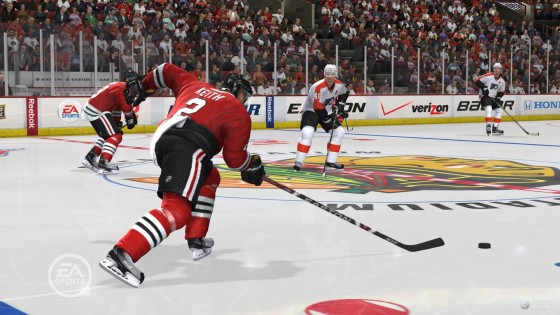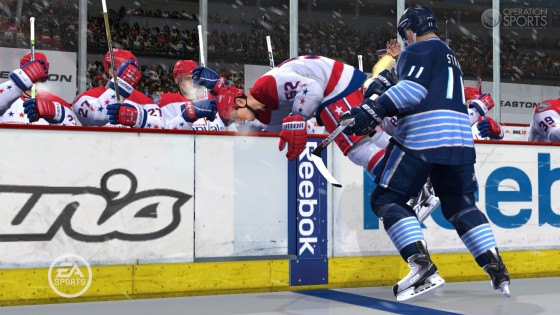

First off, a quick video detour from the mind of the occasionally verbose screenwriter that is Aaron Sorkin:
Hockey, unlike baseball, football or basketball, is a very fluid game by comparison. Stoppages are not planned, nor are they nearly as frequent. In some cases, a game can go on for a good ten minutes without any pauses. Also, possession changes hands quicker and a lot more often than those sports. What this means, in terms of strategizing, is that there are less varieties of “set plays” than other sports. Instead, and especially in the NHL video games, strategies are usually more of a set formation, and most of the time it’s up to you to read and react to the situation. Basically, less set pieces, and more general principles.
In terms of actual strategy, this is one area where the NHL series sorely lacks depth. Basically, all you need to know is to watch the diagram on the strategy screen, the more players you commit to the offensive zone, the more offensive it is, and you are much more liable to give up odd man rushes (counterattacks) if you turn the puck over.

Cycling
There are a few (very) general philosophies to keep in mind. Offensively, the goal, besides scoring, is to keep the puck in your offensive zone for as long as possible, because: that’s how you eventually score; your opponent can’t score from there; even if they get the puck out of the zone, they will be too gassed, and you will have effectively forced them to change lines instead of mounting a counterattack.
At first it may seem a hard task, as you may wonder just how you can keep the puck in a confined zone. That’s where the term “cycling” comes in. As a general rule, defensemen keep attackers on the “outside” by staying between the attacking player and their own net. This means that you, as an attacker, can find the most space working on the outside of the rink. Cycling the puck basically means keeping the puck moving, usually down low (the area perpendicular to, or deeper than, the offensive zone faceoff dots), and along the outside. It may not do much initially, but eventually as you keep the puck moving and get the defense chasing, they may get out of position and you may find an open teammate close to the net.
Another way to score is to generate traffic. You may have heard this term before. It means screening the goalie by crowding the area in front of him. This is usually done by your physical players as they are the hardest to dislodge. With NHL 12, it’s a lot easier to score with point shots because of exactly this. The more the goalie is screened, the greater chance that he loses sight of the puck and lets it fly past him. The other advantage is that, if the goalie ever gives up a juicy rebound right in front of him, you have someone there to tap it in. In NHL 12, crashing the net is the equivalent strategy. It is ideal for teams with physical forwards, and especially for third and fourth lines where skill is limited. Just throw the puck onto the net, who knows what might happen.

Gaining the Zone
This is the one thing that many newcomers have trouble with—getting the puck into the offensive zone to initiate any sort of offense. Because of the offside rule (the attacking team can’t position a man inside the offensive zone before the puck enters it) they have to figure out a way of not only getting into the offensive zone, but controlling the puck in there as well. The easiest way is to simply carry it in, and it will probably work for a while. But as the game goes on and the AI adjusts—especially on higher difficulties—they suddenly become a piñata, getting knocked down on every entry.
Rest assured, there are ways to beat that. First of all, you can shoot or chip the puck in. If the opposing defensemen are hanging around the blue line waiting for you, it may be a good idea to shoot the puck deep into the offensive zone, and retrieve it before the other team can. It can work because the defensemen have to turn around and accelerate all over again to chase the puck, while your forwards are already headed that way with momentum in your favor. The other method, a more advanced one, is the drop pass. Again, this all depends on the situation, but a well timed drop pass —after sucking one of the defenseman in with your original puck carrier— to a streaking teammate from behind can help open space up immensely for a clean entry.

Forechecking
If you’re playing without the puck, then the objective naturally becomes getting the puck back before your opponent scores. That’s checking. Simply put, it’s putting pressure on your opponent to turn the puck over. Forechecking takes place when your opponent tries to break out of their defensive zone.
If you want to be offensive and take the initiative, you can pour men in and try to pin your opponents in their zone with an ungodly amount of pressure. The general rule for forechecking is to remember that you’re putting pressure on as a team. If you’re looking to dispossess the opponent right from the get go, you will most likely fail. Instead of trying to make a hit that may or may not connect, ease up a little and just try to get him to turn back, or shade him to a disadvantageous area (like the corners or sideboards) where his options are more limited than if he goes up the middle.
The one advice that is the same in real life hockey and in NHL 12 is this: keep your feet moving. When you're checking an opponent who is changing directions, don't stop and start, turn instead. Why? Momentum. By the time you've accelerated back to top speed after you've stopped completely, chances are your assigned man will be long gone.
Instead of a high pressure forecheck, perhaps you can try playing with even more patience, as we come to a dirty T-word that’s not to be mentioned to a large population of hockey fans: The Trap. The Trap (and again, this is a very general definition of it) focuses on clogging up the neutral zone. It commits only one man to forechecking, and the rest of the team stays ready in the neutral zone. The idea behind this is to make it as difficult as possible for your opponent to gain a clean entry into your defensive zone because of the offside rule — deny, instead of actively pursue. Basically, an aggressive forecheck tries to make the opponent turn over the puck earlier in the play, but cedes the space in the neutral zone and provides them more space should they break through. A trap, on the other hand, does the exact opposite. In NHL 12, you can try to recreate this by choosing 1-2-2 High as your forechecking strategy.
Which strategy you choose is up to you. If you have a predominantly offensive team, it’s logical to play with a more aggressive forecheck. The tradeoff is that if your opponent does break free, you may have three players stranded deep in the wrong end of the play. On the other hand, if you have pieced together a team full of shot blockers and defensive players, the trap may not be such a bad idea. The tradeoff here is that if you’re playing against a friend, your friendship may likely be at stake after a few games of soul suckingly boring hockey. But then again, looking at the teams still alive in the NHL playoffs, you may also have a legitimate shot at being a pro coach in the near future.
Still hankering for more? Our very own Glenn Wigmore wrote a great piece on how to manage your team’s lines and formations. It’s more advanced than this (most likely because he’s a smarter guy than I am), so if you feel like you’re ready to graduate onto the more in-depth stuff, click away.



